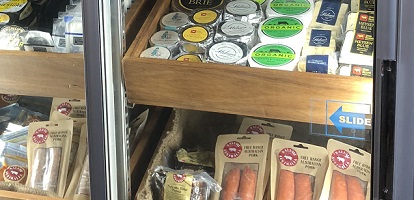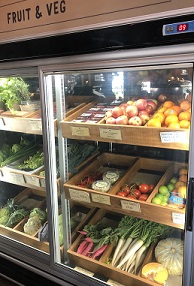Learn to Manage Chilling Through to Freezing of Horticultural and Agricultural Products
Build a solid foundation in the principles of engineering you need to understand and manage refrigeration equipment. A vital course for learning the post harvest horticulture and agriculture skills needed to manage fruit, vegetables, flowers, meat and other farm produce.

Course Duration: 100 hours
Course Structure
This course involves eight lessons.
- Nature & Scope of Refrigeration
- Introduction
- Nature of refrigeration
- Why refrigerate?
- Brief History of refrigeration
- Scope of refrigeration
- What things are refrigerated and what should not be?
- Refrigeration Methods
- Different types of refrigerators
- The Refrigeration Process
- The Refrigeration Process
- Underlying Principles
- Definition of Work
- The Second Law of Thermodynamics
- The Gas Laws
- The refrigeration cycle
- The Vapour Compression System
- Refrigeration components in vapour compression systems
- Compressor
- Condenser
- Liquid Receiver
- Expansion Valve
- Evaporator
- Interconnecting pipework
- Suction Line
- Discharge Line
- Liquid Drain Line
- Liquid Line
- Refrigerant composition
- The domestic refrigerator
- Heat Load Calculations
- Heat gain calculations
- Fabric Heat Gains
- Product Heat Gains
- Air Change Heat Gains
- Occupancy Heat Gains
- Lighting Heat Gains
- Mechanical/Electrical Heat Gains
- The Refrigeration Cycle: Refrigerants & Components
- Refrigerant Selection
- ASHRAE Standards
- Boiling Point/Evaporating Point
- Freezing Point
- Toxicity and Flammability
- Acute Toxicity Exposure Limit (ATEL)
- Practical Limit (PL)
- Global Warming Potential
- Pressure enthalpy chart
- Component selections
- Evaporator Selection
- Compressor Selection
- Condenser Selection
- Expansion Valve Selection
- Applied Refrigeration: Farm Produce
- Fruit
- General Requirements
- Pre-treatment
- Specific Examples
- Vegetables
- General Requirements
- Pre-treatment
- Specific Examples: Precooling
- Specific Examples: Storage Life
- Nuts AND Seeds
- General Requirements
- Specific Examples
- Meat
- General Requirements
- Specific Examples
- Fish
- General Requirements
- Specific Examples
- Dairy
- General Requirements
- Specific Examples
- Applied Refrigeration: Other Products
- Cut Flowers
- General Requirements
- Duration
- Shelf Life
- Post-Harvest Treatments
- Conditioning for Market
- Packaging
- Specific Examples
- Seed Storage Behaviour
- Factors Affecting Storage of Seed
- Types of Seed Storage
- Cold and Cool Rooms in Seed Banks
- Chemicals
- Plant Growth Regulators
- Storing Plant Growth Regulators
- Auxins
- Cytokinins
- Gibberellins
- Agricultural Chemicals
- Freezing Goods
- Why Freeze Food?
- Problems of Freezing
- Other Frozen Agricultural Products
- Commercial Freezing Methods
- Methods
- Commercial Freezing Equipment
- Domestic Freezing
- A few guidelines for freezing
- Power Failure
- Other General Considerations
- Freezing fruits
- Freezing vegetables
- Freezing meat and poultry
- Freezing meat, poultry and fish
- How to Soften Water
Enrol Today
Ready to get started? Click on the orange enrol now button.
Have questions? Click here to email our course counsellors.
Why Refrigeration is Important
Refrigeration has a high impact in society and industry today due to the need to preserve items of food or produce to enable transport to take place over long distances and duration and to keep products at peak freshness. This preservation prevents the spoilage of items for extended periods of time. For instance, freezing food is one of the most effective techniques that can preserve the colour and flavour of fresh products making them more appealing to consumers.

Many food products can become spoiled because of the internal chemical reactions that can cause ripening, fermentation and the growth of certain moulds and bacteria. These processes can be stopped altogether or slowed down significantly by the storage at low temperatures. The optimum storage temperature varies between the different kinds of products. In order to preserve moisture within products, many are stored and chilled in areas where the humidity is kept at a high level. This ensures that moisture is retained in the air and avoids excessive moisture loss from the product.
Fruits and vegetables are generally stored at temperatures above their freezing point with the aim being to prolong their life by days/weeks. In this scenario, the decaying process is slowed down but not completely stopped. Some meats, fish and precooked items are stored at temperatures below their freezing point and only defrosted when they are to be used by the consumer. In this scenario, the decay process is stopped completely.
The Refrigeration Cycle
A refrigeration cycle is a reverse thermodynamic cycle whereby heat is transferred from a body with a lower temperature to a body with a higher temperature through the use of work. Refrigeration cycles come in a variety of formats, with the most widely used being based on the evaporation of a liquid, the Joule-Thomson effect, or the expansion of a working fluid. The refrigeration cycle defines how a product is to be refrigerated.
One of the most efficient refrigeration cycles is the reverse Carnot cycle. The Carnot cycle is approximated by the refrigeration cycle of an ideal vapour-compression
Carnot Cycle & Vapour Compression.
One of the most efficient refrigeration cycles is the reverse Carnot cycle. The Carnot cycle is approximated by the refrigeration cycle of an ideal vapour-compression system. The ideal vapour-compression cycle consists of two adiabatic processes, the compression of a vapour and the expansion of a liquid, and two isothermal processes, the condensing of a vapour and the evaporation of liquid.
Vapour refrigerant is drawn into a compressor and undergoes adiabatic compression. It then enters a condenser where it is condensed back into a liquid isothermally. The liquid refrigerant then returns to the evaporator by dropping its pressure through an expansion device adiabatically. The liquid refrigerant is then evaporated back to a vapour isothermally.
In a real vapour compression system as opposed to the ideal reverse Carnot cycle, the refrigeration cycle entails the superheating of the vapour during compression. In addition, a throttling valve replaces the expansion valve so that the expansion of the refrigerant is isenthalpic rather than adiabatic. As a result, the system efficiency is reduced.
The vapour compression system is the most widely used system of all. It is found in many supermarket environments, within domestic refrigerators and in air conditioning applications again on domestic levels and also commercial.
Absorption
The absorption cycle is very similar to the vapour compression cycle in that it uses a circulating refrigerant, an evaporator, a condenser and an expansion device. The difference is that the compressor is replaced by a chemical absorption process and generator with a pump to provide the circulation and pressure change. As opposed to the vapour compression cycle in which the compressor uses electrical energy to operate, the absorption cycle uses heat to operate. This immediately opens up options for its application and use. Absorption cycles are worth considering if any of the following factors apply:
- Where a combined heat and power (CHP) unit is being installed.
- Where waste heat is available such as exhaust steam.
- A low-cost source of heat is available such as geothermal water/steam.
- An existing site has an electrical load limit that would be too expensive to upgrade.
- A site where solar energy can be harnessed.
Overall these factors are generally applicable to larger industrial scale solutions and typically in factories or food distribution centres is where you will find absorption refrigeration systems.
Adsorption
The operation of adsorption refrigerators is based on the ability of porous solids (the adsorbent) to adsorb the vapour refrigerant when at low temperate and to desorb it when heated. The basic system is comprised of two liked containers, one of which contains the solid adsorbent and is called the generator, and the other is the combined evaporator/condenser in which the refrigerant is evaporated and condensed. As with absorption refrigeration, these systems are typically employed on larger industrial scales where waste industrial heat can be used as a cheap means of raising the system pressure. This is required due to the low efficiencies of this system.